-
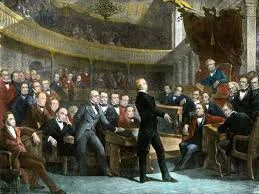 A series of five laws passed in September 1850 to resolve the issue of slavery in territories acquired after the Mexican-American War and to prevent secession. The Compromise allowed California to enter the Union without slavery. This law made it a federal responsibility to capture and return escaped enslaved people to their owners and denied accused individuals a trial.
A series of five laws passed in September 1850 to resolve the issue of slavery in territories acquired after the Mexican-American War and to prevent secession. The Compromise allowed California to enter the Union without slavery. This law made it a federal responsibility to capture and return escaped enslaved people to their owners and denied accused individuals a trial. -
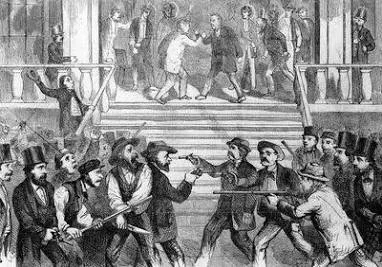 the period of violent conflict in the Kansas Territory from 1854 to 1861, where pro-slavery and anti-slavery settlers fought for political control to determine if the territory would be admitted to the Union as a free or slave state. Key events include the Sack of Lawrence on May 21, 1856, and the Pottawatomie Creek Massacre, which occurred shortly after, on May 24, 1856. Important people include John Brown, an abolitionist leader, and Charles Sumner
the period of violent conflict in the Kansas Territory from 1854 to 1861, where pro-slavery and anti-slavery settlers fought for political control to determine if the territory would be admitted to the Union as a free or slave state. Key events include the Sack of Lawrence on May 21, 1856, and the Pottawatomie Creek Massacre, which occurred shortly after, on May 24, 1856. Important people include John Brown, an abolitionist leader, and Charles Sumner -
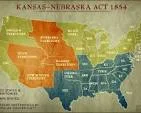 The Kansas-Nebraska Act of 1854 repealed the Missouri Compromise, which had banned slavery in territories north of the (36^{\circ }30^{\prime }) latitude line. It organized the Kansas and Nebraska territories and applied the principle of "popular sovereignty," allowing settlers to vote on whether to allow slavery.
The Kansas-Nebraska Act of 1854 repealed the Missouri Compromise, which had banned slavery in territories north of the (36^{\circ }30^{\prime }) latitude line. It organized the Kansas and Nebraska territories and applied the principle of "popular sovereignty," allowing settlers to vote on whether to allow slavery. -
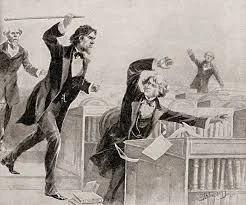 Was a violent assault in which Representative Preston Brooks beat Senator Charles Sumner with a cane on the Senate floor in 1856. The attack was a result of Sumner's anti-slavery speech, "The Crime Against Kansas," which criticized pro-slavery politicians, including Brooks's relative.
Was a violent assault in which Representative Preston Brooks beat Senator Charles Sumner with a cane on the Senate floor in 1856. The attack was a result of Sumner's anti-slavery speech, "The Crime Against Kansas," which criticized pro-slavery politicians, including Brooks's relative. -
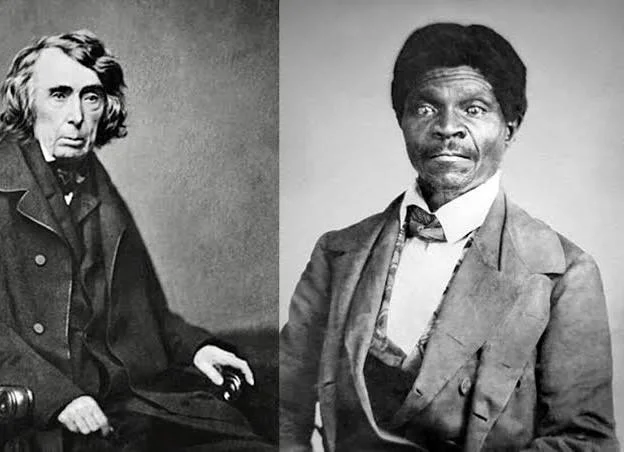 a landmark 1857 Supreme Court case that ruled that African Americans, whether enslaved or free, could not be U.S. citizens and therefore had no right to sue in federal court. The decision also declared the Missouri Compromise of 1820, which banned slavery in federal territories, unconstitutional. The ruling intensified sectional tensions over slavery, moving the country closer to the Civil War.
a landmark 1857 Supreme Court case that ruled that African Americans, whether enslaved or free, could not be U.S. citizens and therefore had no right to sue in federal court. The decision also declared the Missouri Compromise of 1820, which banned slavery in federal territories, unconstitutional. The ruling intensified sectional tensions over slavery, moving the country closer to the Civil War. -
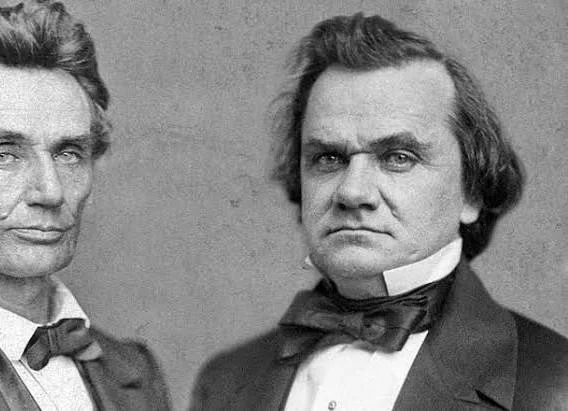 The Lincoln-Douglas debates were a series of seven debates in 1858 between Republican challenger Abraham Lincoln and Democratic incumbent Senator Stephen A. Douglas of Illinois, primarily concerning the issue of slavery and its expansion into new territories. Although Lincoln lost the Senate race, the debates raised his national profile and clarified the fundamental split between the North and South, ultimately positioning him for his presidential victory two years later.
The Lincoln-Douglas debates were a series of seven debates in 1858 between Republican challenger Abraham Lincoln and Democratic incumbent Senator Stephen A. Douglas of Illinois, primarily concerning the issue of slavery and its expansion into new territories. Although Lincoln lost the Senate race, the debates raised his national profile and clarified the fundamental split between the North and South, ultimately positioning him for his presidential victory two years later. -
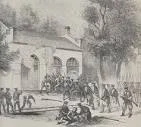 John Brown's raid on Harpers Ferry was an attempt by John Brown to start a slave revolt by seizing the federal armory at Harpers Ferry, Virginia. Brown and his 21 men were quickly surrounded and defeated by local militia and U.S. Marines led by Robert E. Lee. The raid failed, but Brown's subsequent trial and execution turned him into an abolitionist martyr, deepening national divisions over slavery and significantly contributing to the outbreak of the Civil War.
John Brown's raid on Harpers Ferry was an attempt by John Brown to start a slave revolt by seizing the federal armory at Harpers Ferry, Virginia. Brown and his 21 men were quickly surrounded and defeated by local militia and U.S. Marines led by Robert E. Lee. The raid failed, but Brown's subsequent trial and execution turned him into an abolitionist martyr, deepening national divisions over slavery and significantly contributing to the outbreak of the Civil War. -
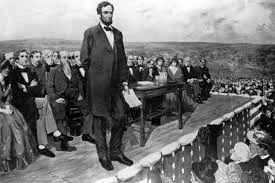 In the 1860 election, Abraham Lincoln ran against three opponents: John C. Breckinridge of the Southern Democrats, Stephen A. Douglas of the Northern Democrats, and John Bell of the Constitutional Union Party. The Democratic Party split over the issue of slavery, leading to the nomination of two separate candidates. The election of Abraham Lincoln in 1860 was significant because it directly led to the secession of southern states and the outbreak of the American Civil War.
In the 1860 election, Abraham Lincoln ran against three opponents: John C. Breckinridge of the Southern Democrats, Stephen A. Douglas of the Northern Democrats, and John Bell of the Constitutional Union Party. The Democratic Party split over the issue of slavery, leading to the nomination of two separate candidates. The election of Abraham Lincoln in 1860 was significant because it directly led to the secession of southern states and the outbreak of the American Civil War.